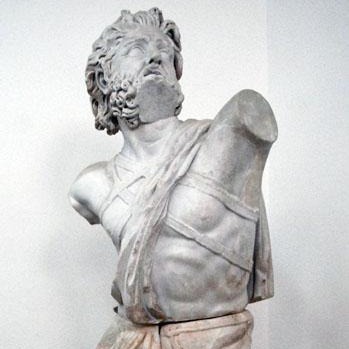티스토리 뷰

Department of Egyptian Antiquities of the Louvre
Room 635/ Aile Sully, Niveau 1
The Crouching Scribe is an Egyptian statue in painted limestone, alabaster, rock crystal and copper representing an Egyptian scribe seated cross-egged.
Probably dating from the 4th or 5th Dynasty (around 2600 BC), it comes from Saqqara where it was discovered in 1850 by the French archaeologist Auguste Mariette in a tomb along the Alley of the Sphinxes of the Serapeum. The Louvre acquired it in 1854. It is kept at the Louvre Museum in Paris and is one of the masterpieces of the art of the Old Egyptian Empire.
In the strict frontality which characterizes Egyptian statues, the scribe, seated cross-legged on a black painted base, is represented in the act of writing. He is dressed in a simple white loincloth. He once held in his right hand a calame (we can still see the hole between the thumb and the index finger which allowed it to be held in place) used for writing and we see on his loincloth a narrow papyrus, partially unrolled. His black hair is short, figured in slight relief and fitting the skull cap; his ears are detached from the head and finely detailed.
-

얼굴 -

얼굴 세부 We note an effort at individualization in the transcription of the character's features: it is a face with angular features, rather emaciated, with high cheekbones and hollow cheeks. The nose is thin as is the mouth and a line of paint marks the eyebrows. The eyes, particularly admirable, are inlaid in the orbits and are made of white magnesite and rock crystal, giving great presence to the gaze. The shoulders are rather broad and the depression of the collarbones is clearly visible.
From behind, they form two clearly visible edges.

손 세부 His body, particularly the torso, is marked by a certain overweight, with bulges at the level of the stomach and hips. The arms are well detached from the body and their musculature is not very marked, however the hands are very fine, all the fingers being subtly individualized. The volume of the legs is described more schematically and we notice that only three of its toes are represented. The nipples are made of wood.
Even if the overall attitude remains a little stiff, the search for realism for the figure, with the quality of the modeling of the face, hands and torso, the lively look of the character and the very beautiful polychromy, entirely intact, make this scribe a major work of Egyptian art. It was made at a time considered the golden age of Egyptian civilization, between the 4th and 5th dynasties, which are those of the great pyramids of Giza.Found anepigraph, no element allows us to identify the Louvre scribe. The hieroglyphic inscription giving the character's name was probably to be found on a base that is now missing, probably lost during the excavation.
In any case, this statue of a scribe is probably that of an important character of his time and it is in no way an official like the others. Being depicted as a scribe was a mark of belonging to the social elite of the Old Kingdom, suggesting that the character was probably, in reality, not a scribe, as the sons of pharaohs appear in this manner quite often. It is therefore very possible that the squatting scribe of the Louvre is a son of a pharaoh of the 4th or 5th dynasty, a hypothesis supported by the very high quality of the sculpture.
When it was found in 1850, it was placed in the tomb's chapel of worship. We can deduce that the statue participated in the ceremonies and received offerings for the deceased and that its function had a funerary character.
'프랑스 > Louvre' 카테고리의 다른 글
| The Scribe Nebmerutef (1) | 2024.04.28 |
|---|---|
| tête de Bénévent (0) | 2024.04.28 |
| suppliante Barberini (0) | 2024.04.15 |
| Apollo Sauroktonos(도마뱀 도살자) (0) | 2024.04.15 |
- Total
- Today
- Yesterday
- Kuzma
- 상트페테르부르크
- Russian Art and Culture
- Netherlandish Painting of the 15th-16th Centuries
- French Painting of the 19th-20th Centuries
- Dutch Painting of the 17th-18th Centuries
- Italian Painting of the 13th-18th Centuries
- 러시아
- 에르미타주
- European Fine Art
- 상트페페트부르크
| 일 | 월 | 화 | 수 | 목 | 금 | 토 |
|---|---|---|---|---|---|---|
| 1 | 2 | 3 | 4 | 5 | ||
| 6 | 7 | 8 | 9 | 10 | 11 | 12 |
| 13 | 14 | 15 | 16 | 17 | 18 | 19 |
| 20 | 21 | 22 | 23 | 24 | 25 | 26 |
| 27 | 28 | 29 | 30 |
